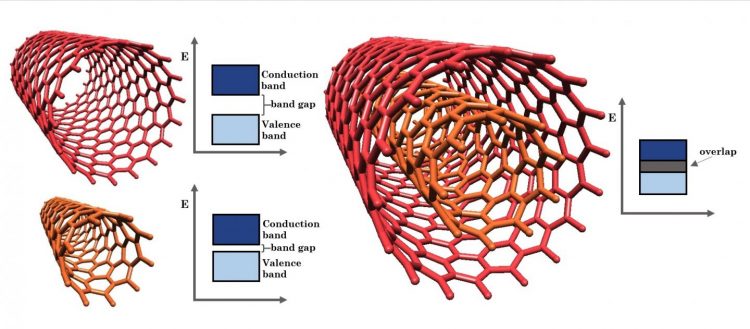Nanotubes with 2 walls have singular qualities

Researchers at Rice University are working to determine the electronic properties of double-walled carbon nanotubes. In this example, the team analyzed a nanotube with two zigzag components. The individual nanotubes have band gaps and are semiconductors, but when combined, the band gaps overlap and make the double-walled a semimetal. Credit: Illustration by Matías Soto/Rice University
Rice University researchers have determined that two walls are better than one when turning carbon nanotubes into materials like strong, conductive fibers or transistors.
Rice materials scientist Enrique Barrera and his colleagues used atomic-level models of double-walled nanotubes to see how they might be tuned for applications that require particular properties. They knew from others' work that double-walled nanotubes are stronger and stiffer than their single-walled cousins. But they found it may someday be possible to tune double-walled tubes for specific electronic properties by controlling their configuration, chiral angles and the distance between the walls.
The research reported in Nanotechnology was chosen as the journal's “publisher's pick” this month. The journal also published an interview with the study's lead author, Rice graduate student Matías Soto.
Carbon nanotubes, grown by various methods, come in two basic varieties: single-walled and multiwalled (those with two or more walls). But double-walled tubes hold a special place in the hierarchy because, the researchers wrote, they behave somewhat like single-walled tubes but are stronger and better able to survive extreme conditions.
The Rice team found there's even more to them when they started looking at how the inner and outer walls match up using tubes with zigzag chirality. Because the electrical properties of single-walled tubes depend on their chirality – the angles of their hexagonal arrangement of atoms – the researchers thought it would be interesting to learn more about those properties in double-walled tubes.
“We saw that the interwall interaction could affect the electronic properties of double-walled carbon nanotubes and decided to study this effect in a more systematic way using computational simulations,” Soto said.
It turned out that both the distance between the walls — as small as a fraction of a nanometer — and the individual chirality of the tubes impact the double-walls' electrical properties. In addition, the researchers found the diameter of the tube — especially the inner one, with its more pronounced curvature — has a small but significant impact on the structure's semiconducting properties.
Breaking it down further, they determined that semiconducting nanotubes wrapped around metallic, highly conductive nanotubes could be the best candidates for tuning the band gap, the property that defines the value of a semiconductor.
“The most interesting thing we found was that when you combine a metallic with a semiconductor, the band gap depends on the distance between them,” Soto said.
It's not yet possible to do so, but the ability to adjust the distance between walls may lead to nanotube transistors, he said.
Other nanotube configurations may be best for turning into macroscopic carbon nanotube conducting wires, particularly with metallic-metallic nanotubes, the researchers found.
###
Co-authors of the paper are Rice graduate students Travis Boyer and postdoctoral researchers Santoshkumar Biradar and Liehui Ge; Robert Vajtai, a senior faculty fellow at Rice; Alex Elías-Zúñiga, a professor at Tecnológico de Monterrey, Mexico; and Pulickel Ajayan, Rice's Benjamin M. and Mary Greenwood Anderson Professor in Engineering and a professor of materials science and nanoengineering and of chemistry. Barrera is a professor of materials science and nanoengineering.
Read the abstract at http://iopscience.
This news release can be found online at http://news.
Follow Rice News and Media Relations via Twitter @RiceUNews
Related Materials:
Lab talk post about the discovery: http://nanotechweb.
Enrique Barrera: https:/
Rice Department of Materials Science and NanoEngineering: https:/
Located on a 300-acre forested campus in Houston, Rice University is consistently ranked among the nation's top 20 universities by U.S. News & World Report. Rice has highly respected schools of Architecture, Business, Continuing Studies, Engineering, Humanities, Music, Natural Sciences and Social Sciences and is home to the Baker Institute for Public Policy. With 3,888 undergraduates and 2,610 graduate students, Rice's undergraduate student-to-faculty ratio is 6-to-1. Its residential college system builds close-knit communities and lifelong friendships, just one reason why Rice is ranked among some of the top schools for best quality of life by the Princeton Review and for best value among private universities by Kiplinger's Personal Finance.
Media Contact
All latest news from the category: Physics and Astronomy
This area deals with the fundamental laws and building blocks of nature and how they interact, the properties and the behavior of matter, and research into space and time and their structures.
innovations-report provides in-depth reports and articles on subjects such as astrophysics, laser technologies, nuclear, quantum, particle and solid-state physics, nanotechnologies, planetary research and findings (Mars, Venus) and developments related to the Hubble Telescope.
Newest articles

NASA: Mystery of life’s handedness deepens
The mystery of why life uses molecules with specific orientations has deepened with a NASA-funded discovery that RNA — a key molecule thought to have potentially held the instructions for…

What are the effects of historic lithium mining on water quality?
Study reveals low levels of common contaminants but high levels of other elements in waters associated with an abandoned lithium mine. Lithium ore and mining waste from a historic lithium…

Quantum-inspired design boosts efficiency of heat-to-electricity conversion
Rice engineers take unconventional route to improving thermophotovoltaic systems. Researchers at Rice University have found a new way to improve a key element of thermophotovoltaic (TPV) systems, which convert heat…



